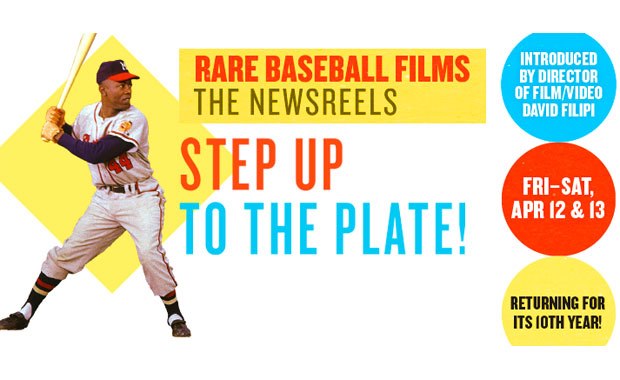By Hope Madden
The sun is shining, the air is warm – it must be spring. If that puts you in the mood to play ball, you sound just like Dave Filipi, Director if Film/Video at the Wexner Center for the Arts.
This year marks the tenth anniversary of Rare Baseball Films, the Wex’s tribute to Filipi’s favorite sport. For the second year running, the footage comes courtesy of the UCLA Film& Television Archive, pulled specifically from their cache of newsreels. The lifelong Minnesota Twins fan took a minute to talk baseball, geekdom, and how well angel dust mixes with bourbon.
Columbus Underground: Rare Baseball Films is in its tenth year. It must be very popular.
Dave Filipi: It’s been pretty popular since the first year, but it’s definitely become more so – seems like more people find us every year. It’s something that I’m personally very interested in, but if it wasn’t popular, we wouldn’t do it this regularly. I like doing it, though. As long as people like it, and as long as I can get footage, we can keep doing it.
CU: So, years back, the season approached and you just got an itch to watch a bunch of baseball movies?
DF: One year, it was getting close to when we’d do our schedule for March and April. I thought it would be fun to do something to mark the beginning of the baseball season. I thought I’d try to do something with the Baseball Hall of Fame.
Because it’s all archival stuff, they don’t let it off the premises. But the person there at the time said, “If you’re willing to show really nice digital transfers, we can send that instead.”
It’s worked out really well because they can send all this footage and we can look at it here and we can edit it here. It actually makes it go a lot smoother.
CU: How do you choose the pieces for the program?
DF: Most of the stuff we show is actually a lot of snippets – maybe the only two interesting minutes out of a 30 minute documentary. A classic example of that from a few years ago is a clip from a film called Baseball Versus Drugs. It’s from the early Seventies, it’s very dry, very clinical. It has doctors sitting behind desks and telling the dangers of drugs.
At almost the very end, there’s a minute or two of this major league baseball player at the time, Pete Richert, who’s visiting a Baltimore classroom with kids who were maybe 9 or 10 years old. He’s telling them not to do drugs, but giving them this inappropriately graphic information. “If you’re taking angel dust and you drink a quart of Jack Daniels…” He’s going into really explicit detail, and these kids are sitting in the class with their mouths open.
Most of that film you would never show to anybody, but that two minutes is what I’m looking for.
CU: What similar highlights we expect this year?
DF: Every year people ask if we’ve found any footage from the Negro Leagues. And it exists, I know it exists, but in working with the Hall of Fame and then with UCLA, no Negro League footage ever came up. But there was a clip this year. It’s really, really interesting.
And there are a couple of clips of Japanese baseball from the Thirties, which is obviously before World War II. One is an American newsreel of the Japanese leagues, and the commentator is pretty racist. He’s trying to be funny, but he’s making all these derogatory comments, any kind of negative verbal stereotype that you can think of. We’ve never had anything like that before.
CU: What are you most excited about?
DF: There’s a really interesting – this is for baseball geeks only – there’s a 30 second clip of Christy Mathewson warming up in 1908. Stuff like that is pretty rare.
CU: You worked with Cooperstown for years but moved to UCLA last year. What prompted the switch?
DF: Because of staff shortages, and just a shortage of resources overall, they (Baseball Hall of Fame) have not been able to provide me with new footage for the last couple of years. It almost got to the point where we would have to stop doing the program.
They’re really hurt. Their budget is very tight and they don’t have the resources. I think people assume – such a popular tourist destination – but they’re not part of Major League Baseball and Major League Baseball doesn’t send them a check for a million dollars every year. They’re a nonprofit like everyone else, and they’re hurting for funds.
UCLA has this incredibly nimble and exhaustive database of newsreels. I can say, Hey, can you do a search of baseball and send me the list? And they sent me this huge list. It’s been great working with them – it’s kind of just like shopping, in a way.
CU: Did this all start because of your own passion for baseball?
DF: I have always really, really loved this game. I really can’t remember not being into baseball. I just was a total fanatic, from a very early age, and not just contemporary baseball. I like history in general, and so I really would get obsessed with Babe Ruth and Roberto Clemente.
Before the Internet, everyone would have a baseball encyclopedia and pick a name and look up how many strike outs they had, things like that. Unlike any other sport, it’s all there in the numbers. You can check out a game in 1910, you see it all there.
You can see it all, too. The program unspools this Friday and Saturday (April 12 and 13) at 7pm. Visit wexarts.org for tickets and details.
Originally published on Columbus Underground.
